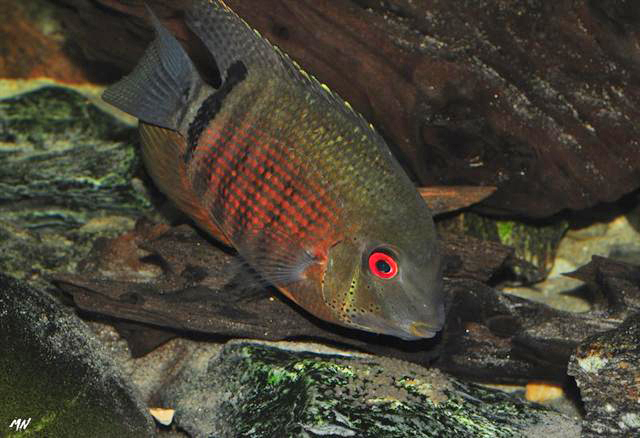| Cichlidae (Cichlids), subfamily: Cichlinae |
| 16.4 cm SL (male/unsexed) |
|
benthopelagic; freshwater; pH range: 4.1 - 6.1 |
| South America: Rio Orinoco basin. |
|
Dorsal spines (total): 15-16; Dorsal soft rays (total): 12-13; Anal spines: 6-7; Anal soft rays: 10-11; Vertebrae: 17-17. Heros liberifer can be diagnosed from all its congeners by having the following characters: a pattern of several horizontal series of bright red dots on the lower half of the body sides (vs. absence of rows of red dots); distinct caudal spot in adult specimens (vs. caudal spot usually merged with bar 2 in adult specimens); and tiny dark dots on operculum and cheeks in adult males (vs. large dots or a vermicular pattern). It differs from adult specimens of the frequently syntopic Heros severus by narrow (vs. thick) lips, bar 4, which is not shortened, but extends from the anal fi n base onto the base of the dorsal fin (vs. bar 4 extending only slightly above the lower lateral line), by the first two anterior hemal spines, which are broader and partially connected (vs. the first three hemal spines connected), and a bright red (vs. brown to dark reddish) iris in live specimens (Ref. 114589). |
| This species is adapted to lentic environment with flooded forest habitats as the typical biotopes. It has no narrow habitat requirement as it is observed not only in clearwater and extreme blackwater habitats, but also in whitewater habitats. It can thrive in a wide range of physico-chemical environmental conditions (pH 4.1-6.1; conductivity 4-15 μS/cm). It spawns in the flooded riparian forest during the flood season. At the start of the dry season, it leaves the riparian forests, which mostly dry up, and spends the low-water season among submerged logs, trunks and branches. During the low-water season, it usually seeks shelter in the crevices and gaps found between the boulders (Ref. 114589). |
|
Least Concern (LC); Date assessed: 28 October 2020 Ref. (130435)
|
| harmless |
Source and more info: www.fishbase.org. For personal, classroom, and other internal use only. Not for publication.

